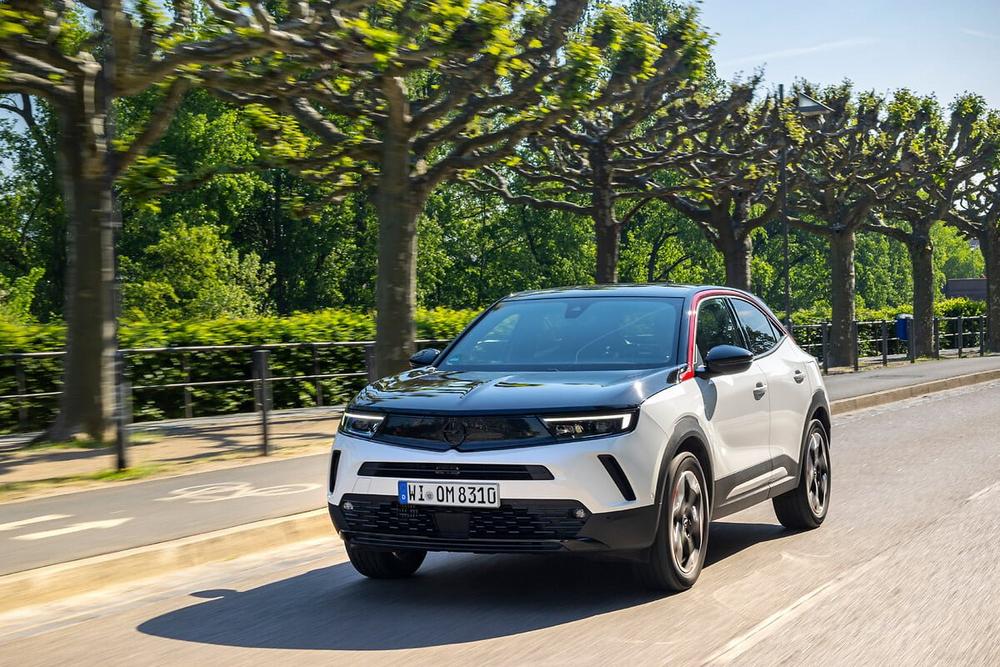- Power with style: Eye-catching Opel SUV with 48-volt hybrid drive for the first time
- High efficiency: Optimal coordination of petrol engine and electric motor lowers fuel consumption by around 20 per cent
- Compact packaging: Mokka Hybrid enables purely electric driving in urban areas
Combined values for Opel Mokka Hybrid according to WLTP1: Fuel consumption 4.9 l/100 km, CO2 emissions 110 g/km; CO2 class: C.
Combined values for Opel Mokka 1.2 Direct Injection Turbo with eight-speed automatic transmission according to WLTP1: Fuel consumption 6.1 l/100 km, CO2 emissions 137 g/km; CO2 class: E.
Opel continues to grow its hybrid portfolio. The stylish Opel Mokka is expanding the offer of cars with the 48-volt technology, with immediate effect. The new Mokka Hybrid with its electrified powertrain is available to order now at a starting price of €31,915 (RRP in Germany including VAT). The combination of a 100 kW (136 hp) turbocharged petrol engine, a 21 kW (28 hp) electric motor and an electrified six-speed dual clutch transmission help to reduce fuel consumption and CO2emissions by up to 20 per cent. At low speeds the Mokka Hybrid even drives purely electrically – locally emissions-free.
Patrick Dinger, Head of Opel Germany: “The new Mokka Hybrid with 48-volt technology sits between the all-electric and conventional drive in our Mokka line-up. The new electrified hybrid system makes driving the Mokka even more efficient for our customers. Those who have not yet sat behind the wheel of an electric car can experience for themselves the benefits of pure electric drive in the city, without more ado.”
New Mokka Hybrid: Electrified driving fun with top efficiency and comfort
In addition to the three-cylinder turbo engine developed specifically for hybrid use, the system of the new Opel Mokka Hybrid includes a 48-volt lithium-ion battery that automatically recharges under deceleration. The electric motor then acts as a generator; an external power source such as a plug socket or charging station to supply the vehicle with electricity is not necessary. Instead, the electric drive assists the petrol engine when accelerating and when starting from a standstill. The torque from the electric motor is delivered especially at low engine speeds, which benefits driving dynamics and CO2 savings. At low speeds, the electric motor also enables fully electric drive for up to one kilometre or up to 50 per cent of the time in the city. The optimally coordinated system is designed to always provide the best performance with the lowest energy consumption.
In figures, this means fuel savings of around 20 per cent compared to a conventionally powered model. While the similar non-electrified Mokka 1.2 Turbo with eight-speed automatic requires 6.1 litres per 100 kilometres in accordance with WLTP1 (CO2 emissions 137 g/km; CO2 class: E), the new Mokka Hybrid only needs 4.9 litres per 100 km (CO2 emissions 110 g/km; CO2 class: C).
The optimal coordination of all components of the hybrid system not only increases fuel efficiency, it is also noticeably reflected in a high level of driving comfort. Depending on their preferences, Mokka Hybrid drivers can choose between the drive modes Eco, Normal and Sport. From zero to 100 km/h, the new Mokka Hybrid takes just 9.1 seconds, and it can accelerate up to a maximum speed of 207 km/h. Thanks to the compact design of the hybrid system, no space is lost in the interior.
Almost no change: Familiar Pure Panel cockpit with additional displays
As usual, Mokka Hybrid drivers can keep an eye on all important information via the fully digital Pure Panel, including driver information centre and colour touchscreen. In addition to the usual information, it also shows further details about electrified operation. Hybrid-specific, for example, are the permanent power and speed displays, where the numbers light up blue when driving purely on electric power and white when running with the combustion engine. Another display shows the energy flow between the battery, petrol engine and wheels, as well as the battery state of charge status in different colours. The most important data on the distance travelled, journey time, average consumption, remaining range and the percentage of the route driven purely electrically can be read via the trip summary when the vehicle is switched off.
[1] A vehicle’s values not only depend on the vehicle’s efficient use of fuel, but are also influenced by driving behaviour and other non-technical factors.
Opel Automobile GmbH
Bahnhofsplatz
65423 Rüsselsheim
Telefon: +49 (6142) 7-70
Telefax: +49 (6142) 77-8409
http://de-media.opel.com/de
Communications, Manager International Product
Telefon: +49 (6142) 69-22084
E-Mail: colin.yong@stellantis.com
Telefon: +49 (6142) 6927811
E-Mail: carina.elsinger@opel-vauxhall.com
![]()
